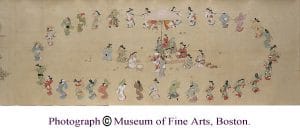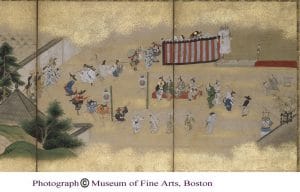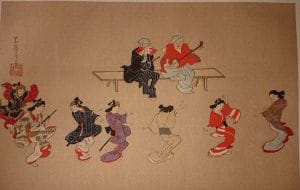Overview
The “age of dance,” which had lasted for about a century, was transformed into the Edo period, a long period of unification and stability under the rule of the government. The culture of the common people sprouted, and the Bon Odori dance took on a form that has continued to the present day.
Era of the Edo Period
Establishment of the Edo system
The castle town developed and the basic form of today’s village community was established. The development of highways and distribution channels stimulated cultural exchange. After the completion of national seclusion, the government shifted from military rule to civilian rule, and the Genroku Culture flourished.
Opening of Edo ~ Genroku Period (1600-1700)
Edo was founded in 1603
Osaka Summer War of 1614
Shimabara Rebellion of 1637
Completion of national isolation in 1641
1651 During the reign of Ietsuna, the 4th Shogun, the government converted from military rule to civilian rule
1688-1704 Genroku period
Basic Information
Population: Approximately 15 million
Attribute types:Nobles, monks, samurai, farmers, merchants. More than 80% are peasants. Towns and cities are populated by merchants and industrialists. (Castle towns, lodging towns, etc.)
Longevity: 40 years old
Famine and disaster conditions: Bad harvests every few years and a major famine once every 50 years
Media of transmission: Only aristocrats, warriors, and village rulers use text, it is mainly transmitted by oral tradition
Domain ownership system: Domain owned by feudal lords and administered by deputies
Common people’s clothing: Development of kosode (small sleeves)
Food of the common people: Mainly millet, foxtail millet, and vegetables
Dwelling of the common people: Thatched dwellings with a layout
Common people’s entertainment/opportunities to dance Bon Dance: Townspeople’s culture developed in each city. Annual events also developed in rural communities. Bon dances became a popular pastime in all of them.
Religion
.
In 1638, the Shogunate implemented the “Shu-mon Aratame (Survey on Religion)” in the territories under its direct control. In 1671, the Shogunate ordered the creation of a “Shumon Nimbetsu Aratamecho ” (Book of Personal and Religious Records). The establishment of “Terauke Seido (Terauke System)
Bon Odori: Events of the time
Toyokuni Festival
The last “townspeople’s” Fu-ryu dance held in August of 1604 (Keicho 9th).
Control of Bon Dancing
In the Edo period (1603-1867), large scale Fu-ryu dances, especially in urban areas, were suppressed, while in the early Edo period, it is assumed that control was rather lenient. According to the flow of the Ofure-gaki (Official Notice),
Keian 2nd : “Dancing is allowed, but fighting and quarreling are not.
Enpo 5: “Do not dance past the appropriate season.
In Jokyo 2, “Aside from children’s Bon dances, dancing in the town is prohibited because it obstructs traffic,” and in Genroku 3, “Sumo wrestling and dancing in the street are prohibited. It can be considered that gradually the control became stronger.
In addition, in the “Bukoh Nenpyo,” a geographical journal of Edo compiled in the late Edo period, there is an entry for the period “Keian 1648-1652” which states, “In this period, when the July Bon Festival is in full swing, the whole city holds dances for men and women, and the night is crowded with people. This implies that there was a possibility that even in Edo (Tokyo), they could dance rather freely
In the local area, the Tokushima no Ofure (notes of Tokushima) described in Shoichiro Miyoshi’s study of the Awa Odori dance can be used as a reference. Here, too, it can be read as a gradual tightening of regulations took place.
| Literary name | Deadline | AD | Content |
|---|---|---|---|
| Saikaku Shokoku-banashi"Yukusue no Takarabune" | Sadayoshi 2 years | 1685 | He said that he would not know the borrowed begging and the fact that he had replaced this place from the 14th. In this July, if you are the first Bon Festival, you will have a good coloring girl in the country, 14 to 25, and a man who has not yet danced, and it is again. A certain thing |
| Keian's Ofuregaki (Edo) | Keian July 2nd | 1649 | Dodeling, but the fighting mouth is Non -sama ..... |
| Enpo's Ofuregaki | In August of the 5th year | 1677 | Dry, now a decoy, Ariyoshihini, the time is no longer appropriate ... (Don't dance after the time) |
| Teikyoi's Ofuregaki | Sadayoshi July 2nd year | 1685 | In the Nikkata Kidata, the climate of the dodgings, the child and the child are exceptional, and the other townsman dancing in the town ... Prohibited because it hinders traffic) |
| Ofure of Genroku 3rd year | Genroku 3rd year | 1690 | Tsuji Sumo Tsuji Tsuji Stopped (sumo wrestling and dancing in traffic) |
| Meirekii's Ofuregaki (Tokushima Domain) | Third year of the year | 1657 | The side eyes of the 20 people are the dances in the tray |
| Kanbun's Ofuregaki (Tokushima clan) | Kanbun 11 years | 1671 | Bon Odori is limited to 3 days from July 14 to 16 |
| Teikyo's Ofuregaki (Tokushima Domain) | Sadayoshi 2 years | 1685 | The spectator orders to see it in an orderly manner |
The Development of the Performing Arts from Furyu Odori
From the Furyu Odori, traditional performing arts representing Japan, such as Okuni Kabuki, Kabuki and Joruri, were born, and at the same time, the prototype for Bon Odori in various regions, which is still popular today, was created. From the Nembutsu (Buddhist prayer) performing arts, traditional performing arts of various regions appeared.
Kabuki Culture
Kabuki Culture reflects the world after the Battle of Sekigahara. It can be characterized by grotesque and male attire.
Popularization of “Kosode”
Revolution in Japanese dress during this period. Kosode spread to the general populace. A culture of flamboyant, self-assertive dress also emerges.
This leads to people enjoy watch others dance.
Shamisen
Ryukyuan sanshin (three-stringed instrument) was introduced and modified into shamisen. In the Edo period (1603-1868), the shamisen was developed and popularized among the general public.
The shamisen became a representative Japanese musical instrument. It also came to be used as an accompaniment for Bon Odori dancing.
Bon Dancing at this time From paintings
Naniwa Kagami
National Diet Library Digital CollectionBon dance from Naniwa-kagami 2 (1680, Enpo 8) (image reprinted by Taisho)[/caption].
Moronobu Hishikawa: 1618 – 1694 (Genroku 7) Variations
.

Photograph ©Museum of Fine Arts, Boston. unauthorized reproduction prohibited
This painting depicts a ring dance in kosode, which is clearly different in aspect from the furyu dances of Muromachi, Sengoku period. The form is ring dance, similar to that of the modern Bon Odori (Bon Dancing). (The timing of the dance is unknown.)Moronobu Hishikawa High Quality Image (Licensed from the Museum of Fine Arts, Boston)
Hanabusa-Iccho: Sho-oh 1(1652)-Kyoho 9 (1724) ( Tsukiji Fuzoku Zu Byobu

Photograph ©Museum of Unauthorized reproduction
The arrangement of faceted lanterns in the hall suggests that this is an Obon dance. A person playing the shamisen can be seen in the center. High-resolution image of Hanabusa-Icho (licensed from the Museum of Fine Arts, Boston).
Hanabusa-Icho: Bon Dance

Hanabusa-Icho Bon Odori *Taisho – Showa Reprinted print (Shonan Bon Odori) (Collection of the Shonan Bon Odori Research Association)
The Beginning of Eisa
It is said that Eisa was first performed in Ryukyu by Saint Taichu in 1603, who introduced the Bon Odori of Fukushima (Jangara Nembutsu lineage) to the Ryukyu Islands.
History of Bon Dance
- 0-1 The History of Uraabon
- 0-2 Ancient Japanese customs of the common people (not documented)
- 0-3 Late Heian Period, just before the birth of Bon Dancing
- 1.Kamakura Period Birth of Dancing Nembutsu
- 10.Heisei Reiwa: From Stagnation to the Birth of a New Axis
- 2.Birth of Bon no Furyu Odori (Bon Dance) in the mid-Muromachi Period
- 3.Late Muromachi – Sengoku – Azuchi-Momoyama Rise of Fuuryu Odori and Regional Expansion
- 4.Early Edo Period Establishment of Bon Dancing
- 5.Mid to Late Edo Period Bon Dancing takes root and matures
- 6.Meiji: A Turning Point for Bon Dancing
- 7.Taisho Era – Early Showa Era Revival of Bon Dancing
- 8.Before and After the War Wartime Response, Suspension and Resumption
- 9.Late mid-Showa period Nationwide expansion of Ondo and Minyo (folk songs)
